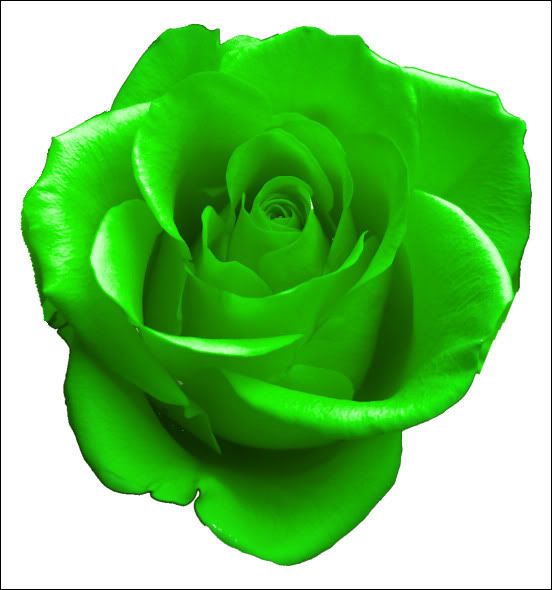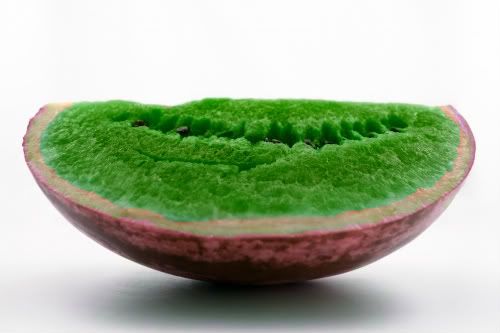
Stop me if you've heard this one: What if the "red" of what you'd call a "red rose" appears to you as actually what other people would call "green" and vice versa? Suppose that this is what a rose looks to everyone but you:

Would you know? Maybe not. Immediately you want to say "well I'd know the first time I called a cucumber 'red' and then everyone stared at me." But you wouldn't call the cucumber "red"; you'd call it "green" because that's what you've been taught is the name of that color. Similarly, when you scoffed at that silly-looking "green" rose pictured above, and discussed it with one of your "normal-sighted" friends they'd scoff as well: "A green rose? That's kinda weird..."
It's a philosophical puzzle, yes, but if I posted about every philosophical puzzle I found interesting we'd have no readership and I'd spend all my time navel-gazing. What's interesting is that I recently read a suggestion that this isn't just plausible but in fact likely for a small minority of the population. You could have this specific experience right now and not know it (!)
Here's the somewhat technical-sounding argument from Psychologist Stephen Palmer (who inspired this post):
The argument goes like this. Normal trichromats have three different pigments in their three cone types. Some people, called protanopes, are red-green color blind because they have a gene that causes their long-wavelength (L) cones to have the same pigment as their medium-wavelength (M) cones. Other people, called deuteranopes, have a different form of red-green color blindness because they have a different gene that causes their M-cones to have the same pigment as their L-cones... Now suppose that someone had the genes for both forms of red-green color blindness simultaneously... Such people, would therefore not be red-green color blind at all, but simply red-green reversed trichromats.{5} They should exist. Assuming they do, they are proof that this color transformation is either undetectable or very difficult to detect by purely behavioral means, because nobody has ever managed to identify one.
They "should exist" and you could well be one of them! It raises all sorts of other questions/considerations too. Consider two adjectives: "fiery" and "lush." Does it seem like a red field could be "lush" in the same way that a green field could?

If you're like me, your gut response is "no way." But if we were to see red as the color of grass all of our lives and to identify a saturated bright, deep red with soft grass and rainforests and ferns would it be different? Rationally that sounds possible, but I honestly can't really imagine it. To me "green" seems to have an inherent capacity for "lushness" that red does not. "Fiery" makes the problem even more evident though; doesn't red seem to have an inherent "fiery-ness" to it? It does to me; it seems fiery in a way that green could never seem "fiery." But of course "fiery" is so named because it's the color of fire, and one would suppose that if we saw fire in shades of green the adjective would remain unchanged.

Of course the irony is that me or someone reading/puzzling over this matter may well be a reverse-tritanope (someone who sees green and red reversed.) You may well walk to the stove after reading this and stare at what most of us would call a "green stove coil" trying to wrap your head around how any other color could seem quite as fiery as does this green, hotly glowing through the coil that's boiling your water.

Could you eat this watermelon?
Some fine print:
At root it's an old idea; at least as old as John Locke. The problem was posed by Locke as the problem of the "Inverted Color Spectrum"; Locke imagines a world in which some people saw the opposite color on the color spectrum than others (yellow for blue, etc.) and concluded that they'd likely never know. There's good reason to think that this isn't true: color isn't as simple as hue as any amateur photoshop-tinkerer knows. Intensity (white and black) is important as is brightness and comparing yellow brightness levels to blue in those hypothetically afflicted would result in disproportionate reports of "brightness" (yellow looks brighter than blue at the same intensity.) Yeah don't take my word for it, take psychologist Stephen Palmer's as it's his counter-proof.
Also it's nearly impossible to remain consistent with color terms in a discussion like this without falling all over yourself saying "what you see as red, but what we'd see as green but still call red" every time. I really dropped the gloves in the final image with the coils, but hopefully the idea was clear enough at that point that it was coherent.
